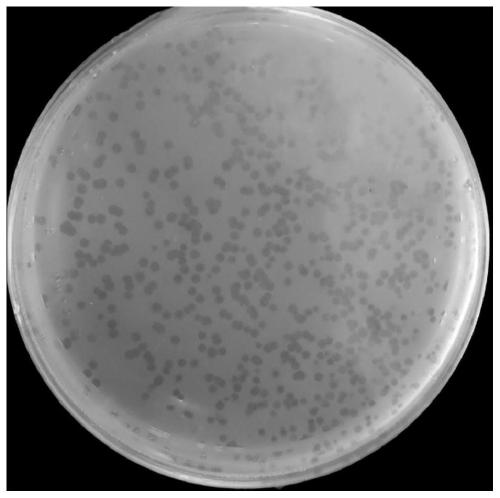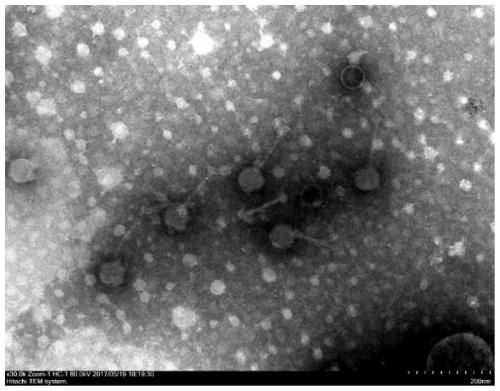Salmonella bacteriophage and application thereof in medicines for preventing and treating salmonella infection diseases
A Salmonella and bacteriophage technology, applied in the field of microorganisms, can solve problems such as antibiotic residues and drug resistance, and achieve the effects of easy industrial production, cost reduction, and chicken mortality reduction.
- Summary
- Abstract
- Description
- Claims
- Application Information
AI Technical Summary
Problems solved by technology
Method used
Image
Examples
Embodiment 1
[0030] The separation and purification of embodiment 1 phage
[0031] An appropriate amount of chicken manure samples were collected from a laying hen farm in Qingdao, Shandong. Take a small amount of sample and add it to the broth medium, and add the prepared 10 strains of Salmonella bacteria to the medium, place the mixture on a constant temperature shaker at 37°C, and cultivate it at 170rpm for about 12h, take the culture solution through a 0.22μm sterile micro Filter through a pore filter to obtain the phage proliferation solution; dilute the phage stock solution by 10 times, take the phage dilution solution and mix them with 10 strains of Salmonella bacteria 1:1, incubate at 37°C for 5 minutes, draw 200 μL of the mixed solution and place it on the upper layer In the agar (agar concentration is 0.7%), after mixing evenly, quickly pour the lower layer of agar (agar concentration is 1.5%) on the plate, shake well and put it flat until the medium is solidified, place it in a ...
Embodiment 2
[0034] Morphological observation of embodiment 2 Salmonella phage SPP11
[0035] Take 20 μL of phage sample and drop it on the copper grid with carbon-coated film, wait for its natural precipitation for 15 minutes, blot dry with filter paper, then stain with 2% (W / V) phosphotungstic acid (PTA) for 1-2 minutes, filter paper Blot dry slightly, and observe and take pictures under a transmission electron microscope after drying.
[0036] The result is as figure 2 It can be seen that the head of phage SPP11 has a polyhedral head structure and a non-contractile tail. The head is 61.54nm wide, 61.54nm long, and the tail is about 134.62nm long. According to the classification method of the International Committee for Taxonomy of Viruses (ICTV), the phage of the present application The morphology conforms to the characteristics of the long-tailed phage family and belongs to the long-tailed phage.
Embodiment 3
[0037] Whole Genome Analysis of Example 3 Phage SPP11
[0038] The genome of bacteriophage SPP11 was extracted for whole genome sequencing and sequence analysis. The results are as follows:
[0039] (1) The full length of the SPP11 genome is 42kb, the G+C content is 49.59%, and the base C, G, A, T contents are 24.75%, 24.84%, 25.21% and 25.20% in sequence. The genome-wide RAST online annotation results showed that the genome contained 66 open reading frames (ORFs), with an average OFR length of 642bp, of which 22 ORFs had known functions, and 44 ORFs were hypothetical protein expression sequences. Among the 66 open reading frames (ORFs), 19 kinds of structural proteins were found, mainly including phage structure and packaging proteins (head protein, tail protein, tail fiber protein, neck protein, capsid protein and terminal enzyme large subunit etc.), bacteriophage cleavage-related proteins (lyases), DNA replication and modification-related proteins (restriction endonuclease...
PUM
 Login to View More
Login to View More Abstract
Description
Claims
Application Information
 Login to View More
Login to View More - R&D
- Intellectual Property
- Life Sciences
- Materials
- Tech Scout
- Unparalleled Data Quality
- Higher Quality Content
- 60% Fewer Hallucinations
Browse by: Latest US Patents, China's latest patents, Technical Efficacy Thesaurus, Application Domain, Technology Topic, Popular Technical Reports.
© 2025 PatSnap. All rights reserved.Legal|Privacy policy|Modern Slavery Act Transparency Statement|Sitemap|About US| Contact US: help@patsnap.com



